Paper Menu >>
Journal Menu >>
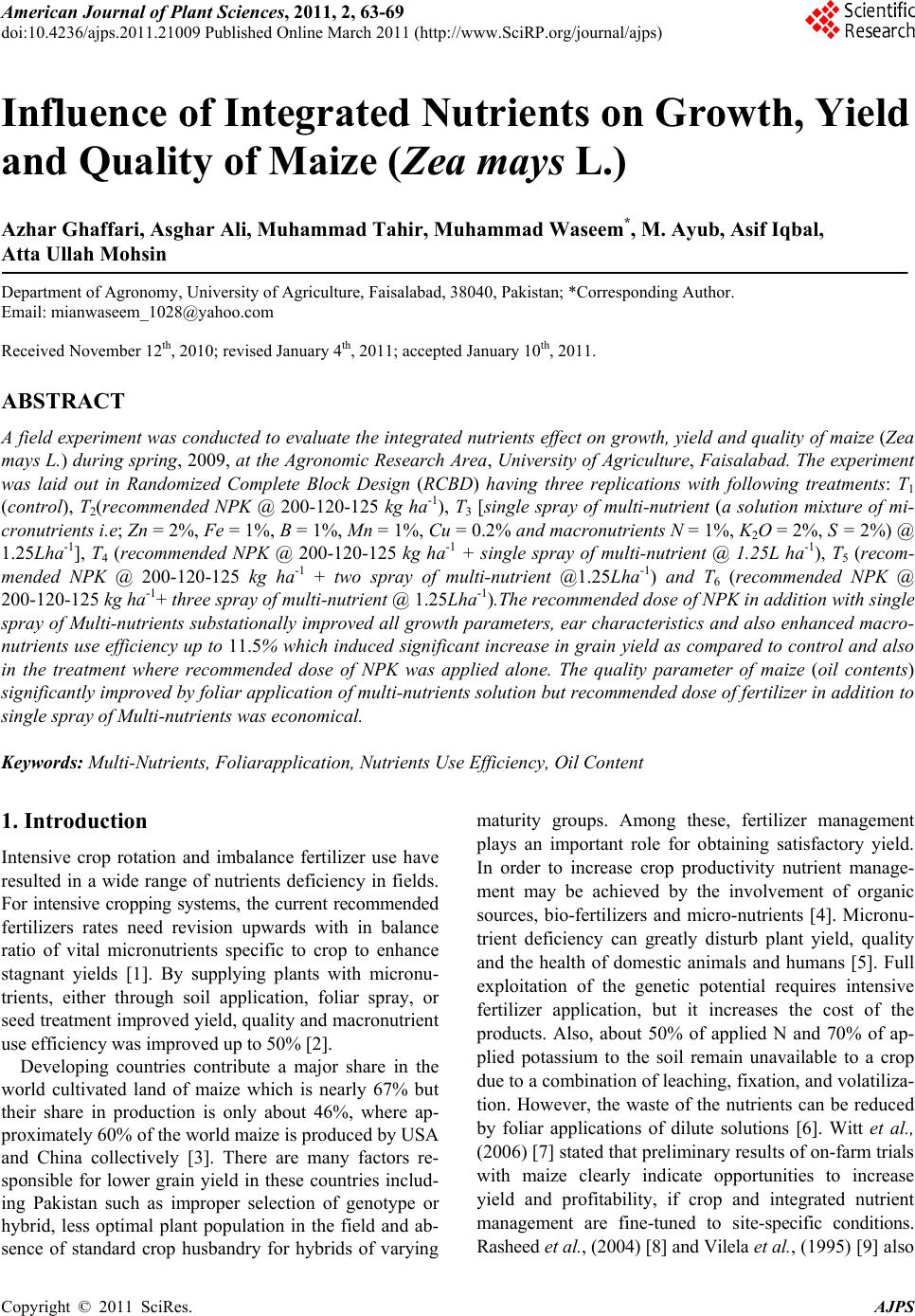 American Journal of Plant Sciences, 2011, 2, 63-69 doi:10.4236/ajps.2011.21009 Published Online March 2011 (http://www.SciRP.org/journal/ajps) Copyright © 2011 SciRes. AJPS 63 Influence of Integrated Nutrients on Growth, Yield and Quality of Maize (Zea mays L.) Azhar Ghaffari, Asghar Ali, Muhammad Tahir, Muhammad Waseem*, M. Ayub, Asif Iqbal, Atta Ullah Mohsin Department of Agronomy, University of Agriculture, Faisalabad, 38040, Pakistan; *Corresponding Author. Email: mianwaseem_1028@yahoo.com Received November 12th, 2010; revised January 4th, 2011; accepted January 10th, 2011. ABSTRACT A field experiment was conducted to evaluate the integrated nutrients effect on growth, yield and quality of maize (Zea mays L.) during spring, 2009, at the Agronomic Research Area, University of Agriculture, Faisalabad. The experimen t was laid out in Randomized Complete Block Design (RCBD) having three replications with following treatments: T1 (control), T2(recommended NPK @ 200-120-125 kg ha-1), T3 [single spray of multi-nutrient (a solution mixture of mi- cronutrients i.e; Zn = 2%, Fe = 1%, B = 1%, Mn = 1%, Cu = 0.2% and macronutrients N = 1%, K2O = 2%, S = 2%) @ 1.25Lha-1], T4 (recommended NPK @ 200-120-125 kg ha-1 + single spray of multi-nutrient @ 1.25L ha-1), T5 (recom- mended NPK @ 200-120-125 kg ha-1 + two spray of multi-nutrient @1.25Lha-1) and T6 (recommended NPK @ 200-120-125 kg ha-1+ three spray o f mu lti-nutrien t @ 1.25Lha-1).The recommended dose of NPK in addition with single spray of Multi-nu trients substationally improved all growth parameters, ear cha racteristics and also enhanced macro- nutrients use efficiency u p to 11.5% which induced significa nt increase in grain yield as compared to co ntrol and also in the treatment where recommended dose of NPK was applied alone. The quality parameter of maize (oil contents) significantly improved b y foliar application of multi-nu trients solution but recommended dose o f fertilizer in addition to single spray of Multi-nutrients was economical. Keywords: Multi-Nutrients, Foliarapplication, Nutrients Use Efficiency, Oil Content 1. Introduction Intensive crop rotation and imbalance fertilizer use have resulted in a wide range of nutrients deficiency in fields. For intensive cropping systems, the current recommended fertilizers rates need revision upwards with in balance ratio of vital micronutrients specific to crop to enhance stagnant yields [1]. By supplying plants with micronu- trients, either through soil application, foliar spray, or seed treatment improved yield, quality and macronutrien t use efficiency was improved up to 50% [2]. Developing countries contribute a major share in the world cultivated land of maize which is nearly 67% but their share in production is only about 46%, where ap- proximately 60% of the world maize is produced by USA and China collectively [3]. There are many factors re- sponsible for lower grain yield in these countries includ- ing Pakistan such as improper selection of genotype or hybrid, less optimal plant population in the field and ab- sence of standard crop husbandry for hybrids of varying maturity groups. Among these, fertilizer management plays an important role for obtaining satisfactory yield. In order to increase crop productivity nutrient manage- ment may be achieved by the involvement of organic sources, bio-fertilizers and micro-nutrients [4]. Micronu- trient deficiency can greatly disturb plant yield, quality and the health of domestic animals and humans [5]. Full exploitation of the genetic potential requires intensive fertilizer application, but it increases the cost of the products. Also, about 50% of applied N and 70% of ap- plied potassium to the soil remain unavailable to a crop due to a combination of leaching, fixation, and volatiliza- tion. However, the waste of the nutrients can be reduced by foliar applications of dilute solutions [6]. Witt et al., (2006) [7] stated th at pr eliminary results o f on-farm trials with maize clearly indicate opportunities to increase yield and profitability, if crop and integrated nutrient management are fine-tuned to site-specific conditions. Rasheed et al., (2004) [8] and Vilela et al., (1995) [9] also 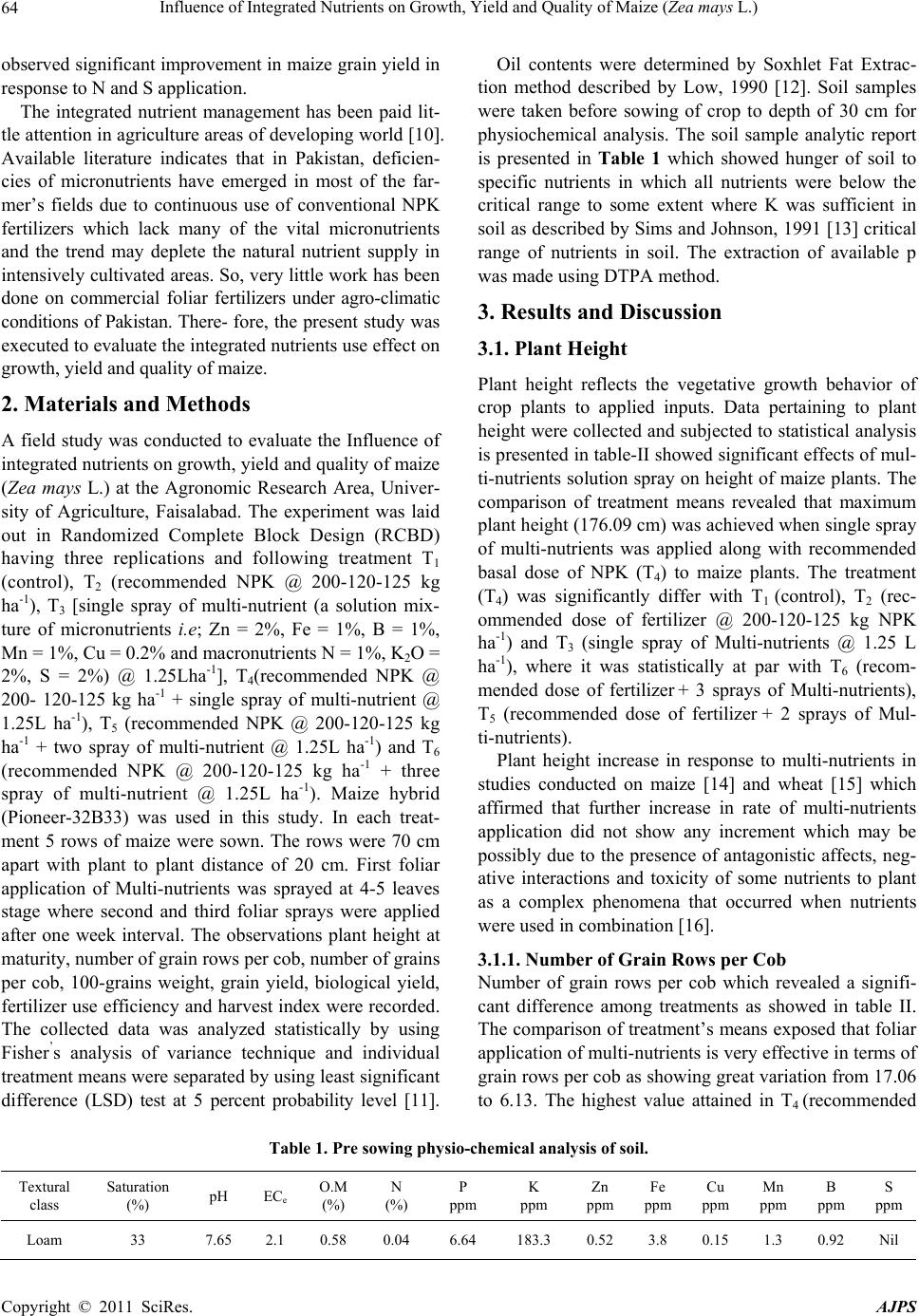 Influence of Integrated Nutrients on Growth, Yield and Quality of Maize (Zea mays L.) Copyright © 2011 SciRes. AJPS 64 observed significant improvement in maize grain yield in response to N and S application. The integrated nutrient management has been paid lit- tle attention in agriculture areas of developing world [10]. Available literature indicates that in Pakistan, deficien- cies of micronutrients have emerged in most of the far- mer’s fields due to continuous use of conventional NPK fertilizers which lack many of the vital micronutrients and the trend may deplete the natural nutrient supply in intensively cultivated areas. So, very little work has been done on commercial foliar fertilizers under agro-climatic conditions of Pakistan. There- for e, the pres ent stu dy w as executed to evaluate th e integrated nutrients use effect on growth, yield and quality of maize. 2. Materials and Methods A field study was conducted to evaluate the Influence of integrated nutrien ts on growth, yield and quality o f maize (Zea mays L.) at the Agronomic Research Area, Univer- sity of Agriculture, Faisalabad. The experiment was laid out in Randomized Complete Block Design (RCBD) having three replications and following treatment T1 (control), T2 (recommended NPK @ 200-120-125 kg ha-1), T3 [single spray of multi-nutrient (a solution mix- ture of micronutrients i.e; Zn = 2%, Fe = 1%, B = 1%, Mn = 1%, Cu = 0.2% and macronutrients N = 1%, K2O = 2%, S = 2%) @ 1.25Lha-1], T4(recommended NPK @ 200- 120-125 kg ha-1 + single spray of multi-nutrient @ 1.25L ha-1), T5 (recommended NPK @ 200-120-125 kg ha-1 + two spray of multi-nutrient @ 1.25L ha-1) and T6 (recommended NPK @ 200-120-125 kg ha-1 + three spray of multi-nutrient @ 1.25L ha-1). Maize hybrid (Pioneer-32B33) was used in this study. In each treat- ment 5 rows of maize were sown. The rows were 70 cm apart with plant to plant distance of 20 cm. First foliar application of Multi-nutrients was sprayed at 4-5 leaves stage where second and third foliar sprays were applied after one week interval. The observations plant height at maturity, number of grain rows per cob, number of grains per cob, 100-grains weight, grain yield, biological yield, fertilizer use efficiency and harvest index were recorded. The collected data was analyzed statistically by using Fisher’s analysis of variance technique and individual tre a t me n t means w er e s ep a r at e d by using least sign ificant difference (LSD) test at 5 percent probability level [11]. Oil contents were determined by Soxhlet Fat Extrac- tion method described by Low, 1990 [12]. Soil samples were taken before sowing of crop to depth of 30 cm for physiochemical analysis. The soil sample analytic report is presented in Table 1 which showed hunger of soil to specific nutrients in which all nutrients were below the critical range to some extent where K was sufficient in soil as described by Sims and Johnson, 1991 [13] critical range of nutrients in soil. The extraction of available p was made using DTPA method. 3. Results and Discussion 3.1. Plant Height Plant height reflects the vegetative growth behavior of crop plants to applied inputs. Data pertaining to plant height were collected and subjected to statistical analysis is presented in table-II show ed significant effects of mul- ti-nutrients solution spray on height of maize plants. The comparison of treatment means revealed that maximum plant height (176.09 cm) was achieved when single spray of multi-nutrients was applied along with recommended basal dose of NPK (T4) to maize plants. The treatment (T4) was significantly differ with T1 (control), T2 (rec- ommended dose of fertilizer @ 200-120-125 kg NPK ha-1) and T3 (single spray of Multi-nutrients @ 1.25 L ha-1), where it was statistically at par with T6 (recom- mended dose of fertilizer + 3 sprays of Multi-nutrients), T5 (recommended dose of fertilizer + 2 sprays of Mul- ti-nutrients). Plant height increase in response to multi-nutrients in studies conducted on maize [14] and wheat [15] which affirmed that further increase in rate of multi-nutrients application did not show any increment which may be possibly due to the presence of antagonistic affects, neg- ative interactions and toxicity of some nutrients to plant as a complex phenomena that occurred when nutrients were used in combination [16]. 3.1.1. Number of Grain Rows per Cob Number of grain rows per cob which revealed a signifi- cant difference among treatments as showed in table II. The comparison of treatment’s means exposed that foliar application of multi-nutrients is very effective in terms of grain rows per cob as showing great variation from 17.06 to 6.13. The highest value attained in T4 (recommended Table 1. Pre sowing physio-chemical analysis of soil. Textural class Saturation (%) pH ECe O.M (%) N (%) P ppm K ppm Zn ppm Fe ppm Cu ppm Mn ppm B ppm S ppm Loam 33 7.65 2.1 0.58 0.04 6.64 183.3 0.52 3.8 0.15 1.3 0.92 Nil 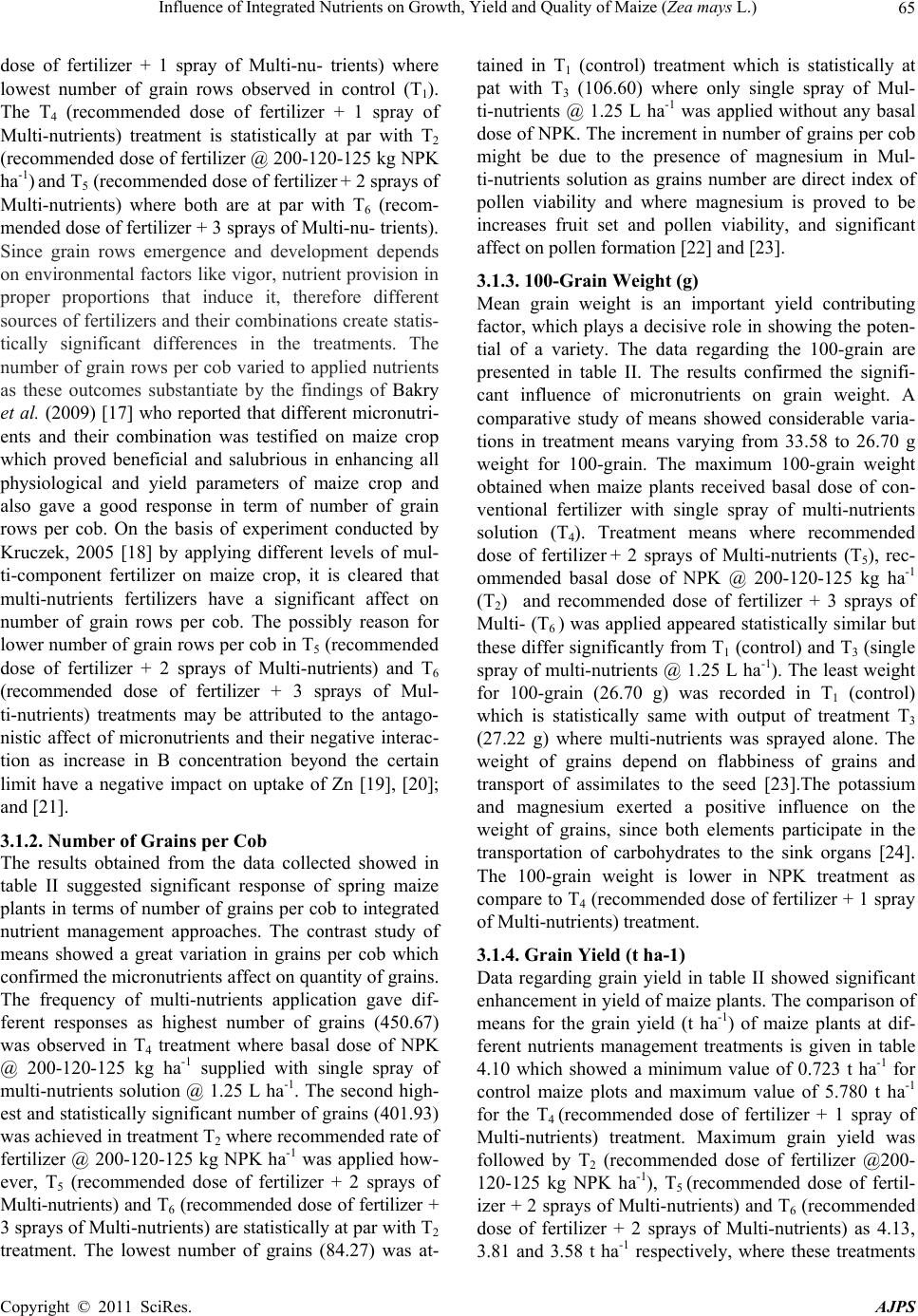 Influence of Integrated Nutrients on Growth, Yield and Quality of Maize (Zea mays L.) Copyright © 2011 SciRes. AJPS 65 dose of fertilizer + 1 spray of Multi-nu- trients) where lowest number of grain rows observed in control (T1). The T4 (recommended dose of fertilizer + 1 spray of Multi-nutrients) treatment is statistically at par with T2 (recommended dose o f fertilizer @ 200-120-125 kg NPK ha-1) and T5 (recommend ed do se o f fertilizer + 2 sprays of Multi-nutrients) where both are at par with T6 (recom- mended dose of fertilizer + 3 sprays of Mu lti-nu- trients). Since grain rows emergence and development depends on environmental factors like vigor, nutrient provision in proper proportions that induce it, therefore different sources of fertilizers and their combinations create statis- tically significant differences in the treatments. The number of grain rows per cob varied to applied nutrients as these outcomes substantiate by the findings of Bakry et al. (2009) [17] who reported that different micronutri- ents and their combination was testified on maize crop which proved beneficial and salubrious in enhancing all physiological and yield parameters of maize crop and also gave a good response in term of number of grain rows per cob. On the basis of experiment conducted by Kruczek, 2005 [18] by applying different levels of mul- ti-component fertilizer on maize crop, it is cleared that multi-nutrients fertilizers have a significant affect on number of grain rows per cob. The possibly reason for lower number of grain rows per cob in T5 (recommended dose of fertilizer + 2 sprays of Multi-nutrients) and T6 (recommended dose of fertilizer + 3 sprays of Mul- ti-nutrients) treatments may be attributed to the antago- nistic affect of micronutrients and their negative interac- tion as increase in B concentration beyond the certain limit have a negative impact on uptake of Zn [19], [20]; and [21]. 3.1.2. Number of Grains per Cob The results obtained from the data collected showed in table II suggested significant response of spring maize plants in terms of number of grains per cob to integrated nutrient management approaches. The contrast study of means showed a great variation in grains per cob which confirmed the micronutrients affect on quantity of grains. The frequency of multi-nutrients application gave dif- ferent responses as highest number of grains (450.67) was observed in T4 treatment where basal dose of NPK @ 200-120-125 kg ha-1 supplied with single spray of multi-nutrients solution @ 1.25 L ha-1. The second high- est and statistically significant nu mber of grains (401.93) was achieved in treatment T2 where recommended rate of fertilizer @ 200-120-125 kg NPK ha-1 was applied how- ever, T5 (recommended dose of fertilizer + 2 sprays of Multi-nutrients) and T6 (recommended dose of fertilizer + 3 sprays of Multi-nutrients) are statistically at par with T2 treatment. The lowest number of grains (84.27) was at- tained in T1 (control) treatment which is statistically at pat with T3 (106.60) where only single spray of Mul- ti-nutrients @ 1.25 L ha-1 was applied without any basal dose of NPK. The increment in number of grains per cob might be due to the presence of magnesium in Mul- ti-nutrients solution as grains number are direct index of pollen viability and where magnesium is proved to be increases fruit set and pollen viability, and significant affect on pol l en formation [22] an d [23]. 3.1.3. 100-Gr a i n Weigh t (g ) Mean grain weight is an important yield contributing factor, which plays a decisive role in showing the poten- tial of a variety. The data regarding the 100-grain are presented in table II. The results confirmed the signifi- cant influence of micronutrients on grain weight. A comparative study of means showed considerable varia- tions in treatment means varying from 33.58 to 26.70 g weight for 100-grain. The maximum 100-grain weight obtained when maize plants received basal dose of con- ventional fertilizer with single spray of multi-nutrients solution (T4). Treatment means where recommended dose of fertilizer + 2 sprays of Multi-nutrients (T5), rec- ommended basal dose of NPK @ 200-120-125 kg ha-1 (T2) and recommended dose of fertilizer + 3 sprays of Multi- (T6 ) was applied appeared statistically similar but these differ significantly from T1 (control) and T3 (single spray of multi-nutrients @ 1.25 L ha-1). The least weight for 100-grain (26.70 g) was recorded in T1 (control) which is statistically same with output of treatment T3 (27.22 g) where multi-nutrients was sprayed alone. The weight of grains depend on flabbiness of grains and transport of assimilates to the seed [23].The potassium and magnesium exerted a positive influence on the weight of grains, since both elements participate in the transportation of carbohydrates to the sink organs [24]. The 100-grain weight is lower in NPK treatment as compare to T4 (recommended dose of fertilizer + 1 spray of Multi-nutrients) treatment. 3.1.4. Grain Yield (t ha-1) Data regarding grain yield in table II showed significant enhancement in yield of maize plants. The comparison of means for the grain yield (t ha-1) of maize plants at dif- ferent nutrients management treatments is given in table 4.10 which showed a minimum value of 0.723 t ha-1 for control maize plots and maximum value of 5.780 t ha-1 for the T4 (recommended dose of fertilizer + 1 spray of Multi-nutrients) treatment. Maximum grain yield was followed by T2 (recommended dose of fertilizer @200- 120-125 kg NPK ha-1), T5 (recommended dose of fertil- izer + 2 sprays of Multi-nutrients) and T6 (recommended dose of fertilizer + 2 sprays of Multi-nutrients) as 4.13, 3.81 and 3.58 t ha-1 respectively, where these treatments  Influence of Integrated Nutrients on Growth, Yield and Quality of Maize (Zea mays L.) Copyright © 2011 SciRes. AJPS 66 were statistically at par with each other. The least grain yield was recorded in T1 (0.72 t ha-1) and T3 (1.24 t ha-1) where single spray of Multi-nutrients@ 1.25 L ha-1 was applied, both were statistically same. This increase may be mainly due to the additional availability of nutrients as foliar sprays where T5 and T6 treatments results were not statistically significant as compare to T4 treatment’s out come. Its might be the multi-nutrients composition of solution which enabled maize plants of treatment T4 to attained maximum grain yield and yield attributes while decline trend in other multi-nutrients treatments might be due to the negative interaction of micronutrients as their concentrations in- creases per treatment [25]. Lisuma et al. (2008) [26]who reported that the use of micronutrients contributed to increase yields when applied in combination of macro- nutrients as compared to conventiona l fertilization which lack of micronutrients. Similar trend was observed by Singh et al., (2009) [27] in wheat crop who claimed that 100% NP plus single spray of micronutrients gave best results in comparison to other treatments. The maxi- mum yield achieved when best site specific nutrient ma- nagement approaches were used, in a study conducted by Bakry et al. (2009) [17] which revealed that micronutri- ents played a critical role in achieving higher yield in conjugation with manures. A decrease trend of grain yield with increasing rate of multi-nutrients solution was also observed by (Lana et al., 2007) [28] who stated th at up to a certain level yield boosts with rising rate of mul- ti-nutrients but further increase in rate of nutrients did not respond linearly and might be it drastically reduces the yield. 3.1.5. Biological Yield (t ha-1) Data pertaining to biological yield as affected by foliar applied different micro- and macro- nutrients is presented in table II. Biological yield differed significantly among various levels of nutrients. The results regarding analysis of variance of post treated data revealed that biological yield of maize plants varied from maximum 15.73 t ha-1 attained in T4 (recommended dose of fertilizer + 1 spray of Multi-nutrients) to lowest value 2.707 t ha-1 observed in control (T1) treatment. Where as the maximum value for biological yield was statistically similar with 13.750 t ha-1 and 12.460 t ha-1, these values gave by treatment T2 (recommended dose of fertilizer @200-120-125 kg NPK ha-1) and T5 (recommended dose of fertilizer + 2 sprays of Multi-nutrients) treated maize plants respectively. In T6 (recommended dose of fertilizer + 3 sprays of Mul- ti-nutrients) treatment biological yield of maize plants was 11.997 t ha-1 which statistically at par with outcome of T2 and T5 treatments. The treatment T3 where single spray of multi-nutrients@ 1.25 L ha-1 was sprayed with- out any basal dose of NPK showed 6.180 t ha-1 biological yield, which significantly differed from control (2.707 t ha-1) treatment. The biological yield increment might be due to man- ganese application which significantly improve uptake of Mg, Zn and Mn in corn. So, micronutrients may be at- tributed enhanced photosynthesis, early growth and ni- trogen fixation as Zn and other vital nutrients was present in multi-nutrients solution. These results are in confor- mity with findings of Ali et al. (2008) [28] and Welch (2003) [5] who stated that application of micronutrients combinations gave highest biological yield as grain yield was also influenced which might be attributed to the ad- ditional availability of nutrients. Similar pattern in re- sponse to mix fertilization of micronutrients in maize was also giv en by Lana et al., (2007)[29]. 3.1.6. Harvest Index (%) The physiological ability of a hybrid to convert total dry matter in to grain yield is determined by its Harvest In- dex (HI). The Table 2 pertain the data concerning har- vest index (HI) of maize plants as affected by nutrient management practices. The analyzed data revealed that significant affect on harvest index was observed among fertilizer treatments. The comparison of mean study showed variation in har- vest index from 36.638 to 24.297. The maximum value for harvest index was observed in T4 where recom- mended dose of basal fertilizer along with 1 spray of Multi-nutrients was applied. The treatments T2 (recom- mended dose of fertilizer@200-120-125 kg NPK ha-1), T5 (recommended dose of fertilizer + 2 sprays of Mul- ti-nutrients) and T6 (recommended dose of fertilizer + 3 sprays of Multi-nutrients) was statistically similar for harvest index values 30.447, 30.283 and 29.260 respec- tively. The least harvest index (24.297) was recorded in control treatment which was statistically at par with out- come of single spray of Multi-nutrients@ 1.25 L ha-1 treated maize plants in T3 treatment (25.217). These results are in agreement with the findings of the Sajedi et al. (2009) [30] who investigated the micronu- trients impact on salinity stressed maize plants under water deficit conditions. The outcomes of this study proved that harvest index was significantly affected by micronutrients application when maize plants were re- ceiving normal irrigation and no selenium was applied. 3.1.7. Fertilizer Use Efficiency (kg-1) Fertilizer Use Efficiency (FUE) is also called nutrient to grain ratio. The major macronutrients (N, P and K) use efficiency was significantly influenced by micronutrients foliar sprayed as showed in table II. The treatments showed that highest FUE was observed in T4 where 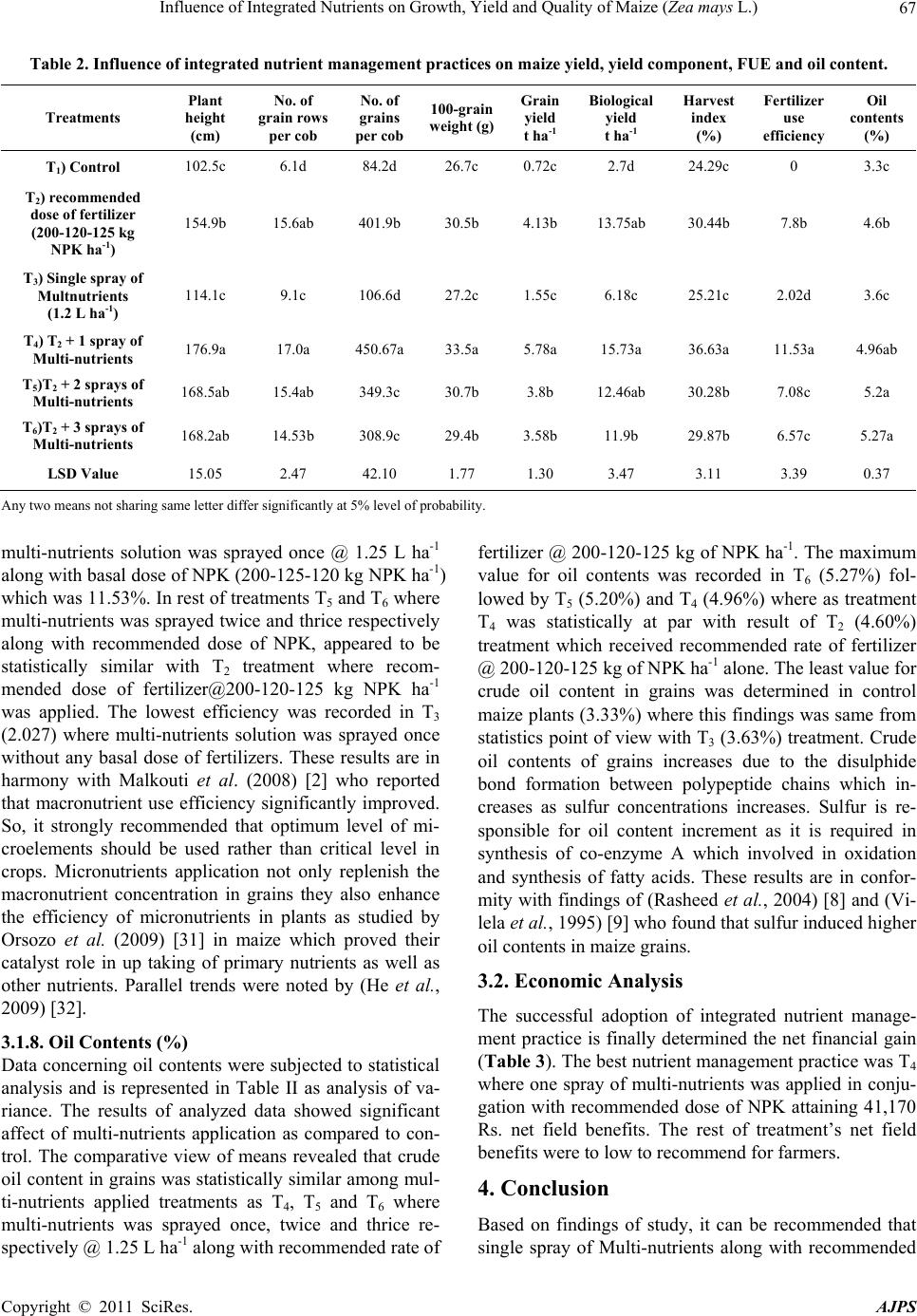 Influence of Integrated Nutrients on Growth, Yield and Quality of Maize (Zea mays L.) Copyright © 2011 SciRes. AJPS 67 Table 2. Influence of integrated nutrient management practices on maize yield, yield component, FUE and oil content. Treatments Plant height (cm) No. of grain rows per cob No. of grains per cob 100-grain weight (g) Grain yield t ha-1 Biological yield t ha-1 Harvest index (%) Fertilizer use efficiency Oil contents (%) T1) Control 102.5c 6.1d 84.2d 26.7c 0.72c 2.7d 24.29c 0 3.3c T2) recommended dose of fertilizer (200-120-125 kg NPK ha-1) 154.9b 15.6ab 401.9b 30.5b 4.13b 13.75ab 30.44b 7.8b 4.6b T3) Single spray of Multnutrients (1.2 L ha-1) 114.1c 9.1c 106.6d 27.2c 1.55c 6.18c 25.21c 2.02d 3.6c T4) T2 + 1 spray of Multi-nutrients 176.9a 17.0a 450.67a33.5a 5.78a 15.73a 36.63a 11.53a 4.96ab T5)T2 + 2 sprays of Multi-nutrients 168.5ab 15.4ab 349.3c 30.7b 3.8b 12.46ab 30.28b 7.08c 5.2a T6)T2 + 3 sprays of Multi-nutrients 168.2ab 14.53b 308.9c 29.4b 3.58b 11.9b 29.87b 6.57c 5.27a LSD Value 15.05 2.47 42.10 1.77 1.30 3.47 3.11 3.39 0.37 Any two means not sharing same letter differ significantly at 5% level of probability. multi-nutrients solution was sprayed once @ 1.25 L ha-1 along with ba sal dose of NPK (200 -125-1 20 kg NPK ha-1) which was 11.53%. In rest of treatments T5 and T6 where multi-nutrients was sprayed twice and thrice respectiv ely along with recommended dose of NPK, appeared to be statistically similar with T2 treatment where recom- mended dose of fertilizer@200-120-125 kg NPK ha-1 was applied. The lowest efficiency was recorded in T3 (2.027) where multi-nutrients solution was sprayed once without any basal dose of fertilizers. These results are in harmony with Malkouti et al. (2008) [2] who reported that macronutrient use efficiency significantly improved. So, it strongly recommended that optimum level of mi- croelements should be used rather than critical level in crops. Micronutrients application not only replenish the macronutrient concentration in grains they also enhance the efficiency of micronutrients in plants as studied by Orsozo et al. (2009) [31] in maize which proved their catalyst role in up taking of primary nutrients as well as other nutrients. Parallel trends were noted by (He et al., 2009) [32]. 3.1.8. Oil Contents (%) Data concerning oil contents were subjected to statistical analysis and is represented in Table II as analysis of va- riance. The results of analyzed data showed significant affect of multi-nutrients application as compared to con- trol. The comparative view of means revealed that crude oil content in grains was statistically similar among mul- ti-nutrients applied treatments as T4, T5 and T6 where multi-nutrients was sprayed once, twice and thrice re- spectively @ 1.25 L ha-1 along with recommended rate of fertilizer @ 200-120-125 kg of NPK h a-1. The maxi mum value for oil contents was recorded in T6 (5.27%) fol- lowed by T5 (5.20%) and T4 (4.96%) where as treatment T4 was statistically at par with result of T2 (4.60%) treatment which received recommended rate of fertilizer @ 200-120-125 kg of NPK ha-1 alone. The least value for crude oil content in grains was determined in control maize plants (3.33%) where this findings was same from statistics point of view with T3 (3.63%) treatment. Crude oil contents of grains increases due to the disulphide bond formation between polypeptide chains which in- creases as sulfur concentrations increases. Sulfur is re- sponsible for oil content increment as it is required in synthesis of co-enzyme A which involved in oxidation and synthesis of fatty acids. These results are in confor- mity with findings of (Rasheed et al., 2004) [8] and (V i- lela et al., 1995) [9] who fo un d th at sulfur indu ced high er oil contents in maize grains. 3.2. Economic Analysis The successful adoption of integrated nutrient manage- ment practice is finally determined the net financial gain (Table 3). The best nutrient management practice was T4 where one spray of multi-nutrients was applied in conju- gation with recommended dose of NPK attaining 41,170 Rs. net field benefits. The rest of treatment’s net field benefits were to low to recommend for farmers. 4. Conclusion Based on findings of study, it can be recommended that single spray of Multi-nutrients along with recommended 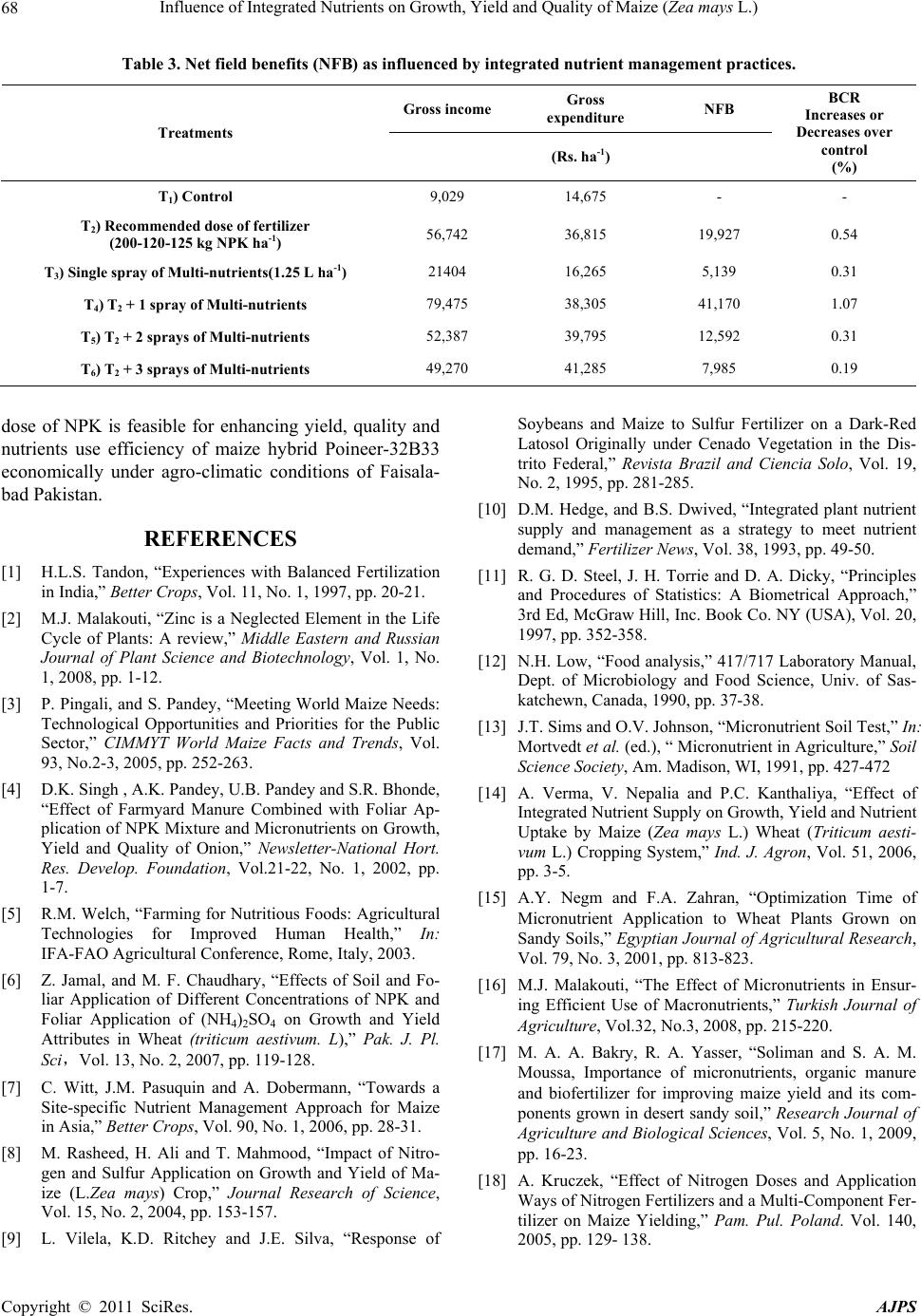 Influence of Integrated Nutrients on Growth, Yield and Quality of Maize (Zea mays L.) Copyright © 2011 SciRes. AJPS 68 Table 3. Net field benefits (NFB) as influenced by integrated nutrient management practices. Gross incomeGross expenditure NFB Treatments (Rs. ha-1) BCR Increases or Decreases over control (%) T1) Control 9,029 14,675 - - T2) Recommended dose of fertilizer (200-120-125 kg NPK ha-1) 56,742 36,815 19,927 0.54 T3) Single spray of Multi-nutrients(1.25 L ha-1) 21404 16,265 5,139 0.31 T4) T2 + 1 spray of Multi-nutrients 79,475 38,305 41,170 1.07 T5) T2 + 2 sprays of Multi-nutrients 52,387 39,795 12,592 0.31 T6) T2 + 3 sprays of Multi-nutrients 49,270 41,285 7,985 0.19 dose of NPK is feasible for enhancing yield, quality and nutrients use efficiency of maize hybrid Poineer-32B33 economically under agro-climatic conditions of Faisala- bad Pakistan. REFERENCES [1] H.L.S. Tandon, “Experiences with Balanced Fertilization in India,” Better Crops, Vol. 11, No. 1, 1997, pp. 20-21. [2] M.J. Malakouti, “Zinc is a Neglected Element in the Life Cycle of Plants: A review,” Middle Eastern and Russian Journal of Plant Science and Biotechnology, Vol. 1, No. 1, 2008, pp. 1-12. [3] P. Pingali, and S. Pa ndey, “Meeting World Maize Nee ds: Technological Opportunities and Priorities for the Public Sector,” CIMMYT World Maize Facts and Trends, Vol. 93, No.2-3, 2005, pp. 252-263. [4] D.K. Singh , A.K. Pandey, U.B. Pandey and S.R. Bhonde, “Effect of Farmyard Manure Combined with Foliar Ap- plication of NPK Mixture and Micronutrients on Growth, Yield and Quality of Onion,” Newsletter-National Hort. Res. Develop. Foundation, Vol.21-22, No. 1, 2002, pp. 1-7. [5] R.M. Welch, “Farming for Nutritious Foods: Agricultural Technologies for Improved Human Health,” In: IFA-FAO Agricultural Conference, Rome, Italy, 2003. [6] Z. Jamal, and M. F. Chaudhary, “Effects of Soil and Fo- liar Application of Different Concentrations of NPK and Foliar Application of (NH4)2SO4 on Growth and Yield Attributes in Wheat (triticum aestivum. L),” Pak. J. Pl. Sci,Vol. 13, No. 2, 2007, pp. 119-128. [7] C. Witt, J.M. Pasuquin and A. Dobermann, “Towards a Site-specific Nutrient Management Approach for Maize in Asia,” Better Crops, Vol. 90, No. 1, 2006, pp. 28-31. [8] M. Rasheed, H. Ali and T. Mahmood, “Impact of Nitro- gen and Sulfur Application on Growth and Yield of Ma- ize (L.Zea mays) Crop,” Journal Research of Science, Vol. 15, No. 2, 2004, pp. 153-157. [9] L. Vilela, K.D. Ritchey and J.E. Silva, “Response of Soybeans and Maize to Sulfur Fertilizer on a Dark-Red Latosol Originally under Cenado Vegetation in the Dis- trito Federal,” Revista Brazil and Ciencia Solo, Vol. 19, No. 2, 1995, pp. 281-285. [10] D.M. Hedge, and B.S. Dwived, “Integrated plant nutrient supply and management as a strategy to meet nutrient demand,” Fertilizer News, Vol. 38, 1993, pp. 49-50. [11] R. G. D. Steel, J. H. Torrie and D. A. Dicky, “Principles and Procedures of Statistics: A Biometrical Approach,” 3rd Ed, McGraw Hill, Inc. Book Co. NY (USA), Vol. 20, 1997, pp. 352-358. [12] N.H. Low, “Food analysis,” 417/717 Laboratory Manual, Dept. of Microbiology and Food Science, Univ. of Sas- katchewn, Canada, 1990, pp. 37-38. [13] J.T. Sims and O.V. Johnson, “Micronutrient Soil Test,” In: Mortvedt et al. (ed.), “ Micronutrient in Agriculture,” Soil Science Society, Am. Madison, WI, 1991, pp. 427-472 [14] A. Verma, V. Nepalia and P.C. Kanthaliya, “Effect of Integrated Nutrient Supply on Growth, Yield and Nutrient Uptake by Maize (Zea mays L.) Wheat (Triticum aesti- vum L.) Cropping System,” Ind. J. Agron, Vol. 51, 2006, pp. 3-5. [15] A.Y. Negm and F.A. Zahran, “Optimization Time of Micronutrient Application to Wheat Plants Grown on Sandy Soils,” Egyptian Journal of Agricultural Research, Vol. 79, No. 3, 2001, pp. 813-823. [16] M.J. Malakouti, “The Effect of Micronutrients in Ensur- ing Efficient Use of Macronutrients,” Turkish Journal of Agriculture, Vol.32, No.3, 2008, pp. 215-220. [17] M. A. A. Bakry, R. A. Yasser, “Soliman and S. A. M. Moussa, Importance of micronutrients, organic manure and biofertilizer for improving maize yield and its com- ponents grown in desert sandy soil,” Research Journal of Agriculture and Biological Sciences, Vol. 5, No. 1, 2009, pp. 16-23. [18] A. Kruczek, “Effect of Nitrogen Doses and Application Ways of Nitrogen Fertilizers and a Multi-Component Fer- tilizer on Maize Yielding,” Pam. Pul. Poland. Vol. 140, 2005, pp. 129- 138. 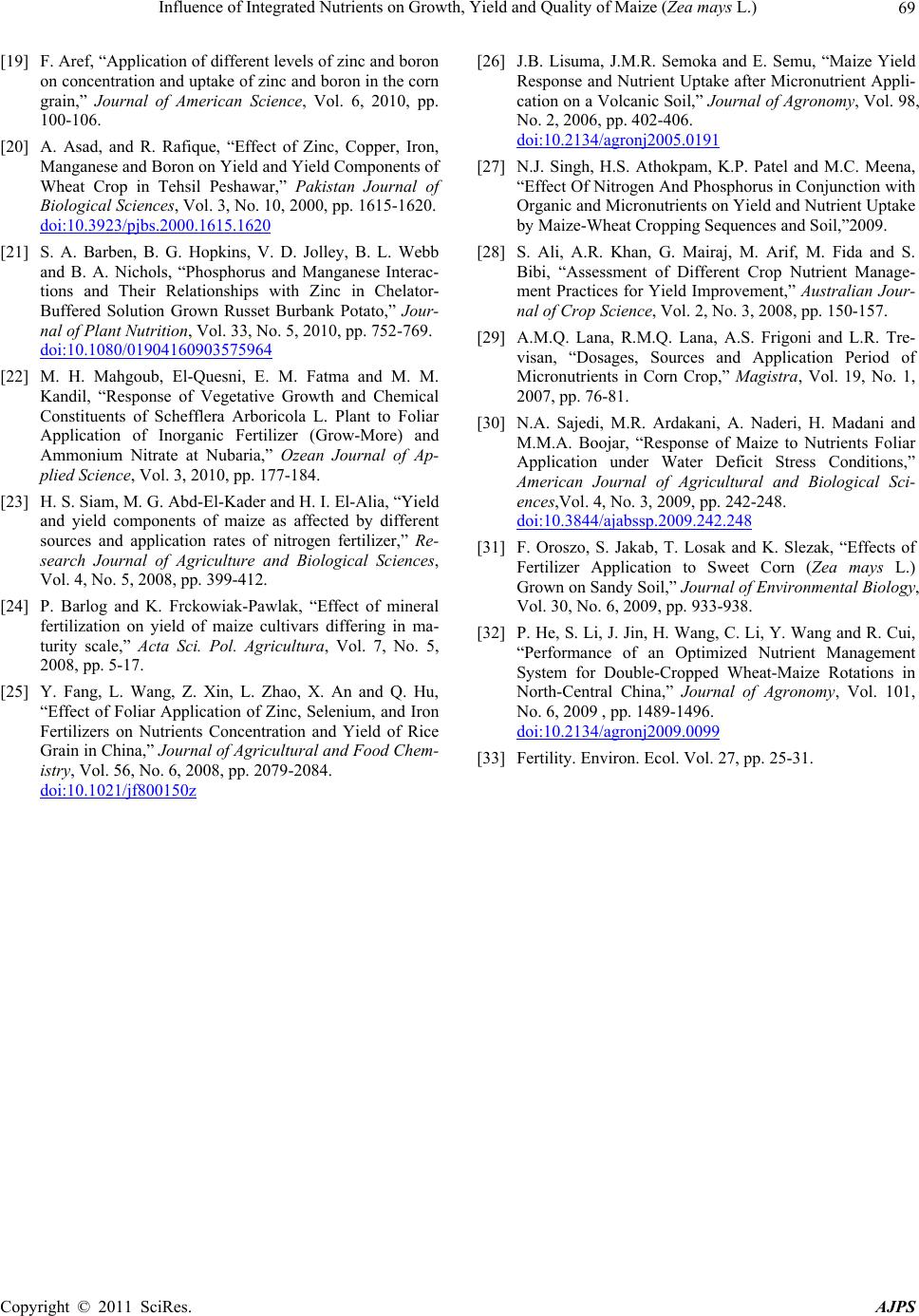 Influence of Integrated Nutrients on Growth, Yield and Quality of Maize (Zea mays L.) Copyright © 2011 SciRes. AJPS 69 [19] F. Aref, “Application of different levels of zinc and boron on concentration and uptake of zinc and boron in the corn grain,” Journal of American Science, Vol. 6, 2010, pp. 100-106. [20] A. Asad, and R. Rafique, “Effect of Zinc, Copper, Iron, Manganese and Boron on Yield and Yield Components of Wheat Crop in Tehsil Peshawar,” Pakistan Journal of Biological Sciences, Vol. 3, No. 10, 2000, pp. 1615-1620. doi:10.3923/pjbs.2000.1615.1620 [21] S. A. Barben, B. G. Hopkins, V. D. Jolley, B. L. Webb and B. A. Nichols, “Phosphorus and Manganese Interac- tions and Their Relationships with Zinc in Chelator- Buffered Solution Grown Russet Burbank Potato,” Jour- nal of Plant Nutrition, Vol. 33, No. 5, 2010, pp. 752-769. doi:10.1080/01904160903575964 [22] M. H. Mahgoub, El-Quesni, E. M. Fatma and M. M. Kandil, “Response of Vegetative Growth and Chemical Constituents of Schefflera Arboricola L. Plant to Foliar Application of Inorganic Fertilizer (Grow-More) and Ammonium Nitrate at Nubaria,” Ozean Journal of Ap- plied Science, Vol. 3, 2010, pp. 177-184. [23] H. S. Siam, M. G. Abd-El-Kader and H. I. El-Alia, “Yield and yield components of maize as affected by different sources and application rates of nitrogen fertilizer,” Re- search Journal of Agriculture and Biological Sciences, Vol. 4, No. 5, 2008, pp. 399-412. [24] P. Barlog and K. Frckowiak-Pawlak, “Effect of mineral fertilization on yield of maize cultivars differing in ma- turity scale,” Acta Sci. Pol. Agricultura, Vol. 7, No. 5, 2008, pp. 5-17. [25] Y. Fang, L. Wang, Z. Xin, L. Zhao, X. An and Q. Hu, “Effect of Foliar Application of Zinc, Selenium, and Iron Fertilizers on Nutrients Concentration and Yield of Rice Grain in China,” Journal of Agricultural and Food Chem- istry, Vol. 56, No. 6, 2008, pp. 2079-2084. doi:10.1021/jf800150z [26] J.B. Lisuma, J.M.R. Semoka and E. Semu, “Maize Yield Response and Nutrient Uptake after Micronutrient Appli- cation on a Volcanic Soil,” Journal of Agronomy, Vol. 98, No. 2, 2006, pp. 402-406. doi:10.2134/agronj2005.0191 [27] N.J. Singh, H.S. Athokpam, K.P. Patel and M.C. Meena, “Effect Of Nitrogen And Phosphorus in Conjunction with Organic and Micronutrients on Yield and Nutrient Uptake by Maize-Wheat Cropping Sequences and Soil,”2009. [28] S. Ali, A.R. Khan, G. Mairaj, M. Arif, M. Fida and S. Bibi, “Assessment of Different Crop Nutrient Manage- ment Practices for Yield Improvement,” Australian Jour- nal of Crop Science, Vol. 2, No. 3, 2008, pp. 150-157. [29] A.M.Q. Lana, R.M.Q. Lana, A.S. Frigoni and L.R. Tre- visan, “Dosages, Sources and Application Period of Micronutrients in Corn Crop,” Magistra, Vol. 19, No. 1, 2007, pp. 76-81. [30] N.A. Sajedi, M.R. Ardakani, A. Naderi, H. Madani and M.M.A. Boojar, “Response of Maize to Nutrients Foliar Application under Water Deficit Stress Conditions,” American Journal of Agricultural and Biological Sci- ences,Vol. 4, No. 3, 2009, pp. 242-248. doi:10.3844/ajabssp.2009.242.248 [31] F. Oroszo, S. Jakab, T. Losak and K. Slezak, “Effects of Fertilizer Application to Sweet Corn (Zea mays L.) Grown on Sandy Soil,” Journal of Environmental Biology, Vol. 30, No. 6, 2009, pp. 933-938. [32] P. He, S. Li, J. Jin, H. Wang, C. Li, Y. Wang and R. Cui, “Performance of an Optimized Nutrient Management System for Double-Cropped Wheat-Maize Rotations in North-Central China,” Journal of Agronomy, Vol. 101, No. 6, 2009 , pp. 1489-1496. doi:10.2134/agronj2009.0099 [33] Fertility. Environ. Ecol. Vol. 27, pp. 25-31. |

